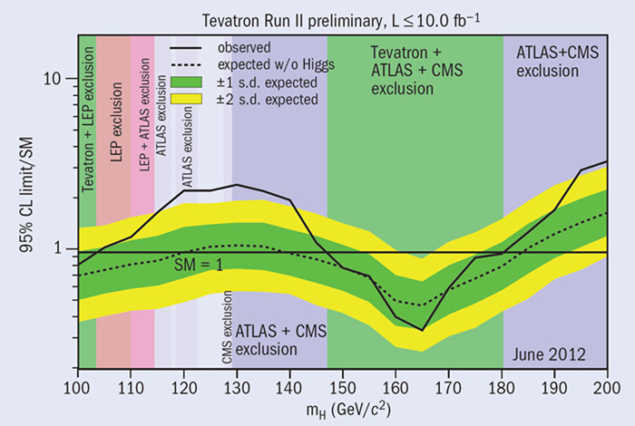
The CDF and DØ collaborations at Fermilab have found evidence for the production of a Higgs-like particle decaying into a pair of bottom and antibottom quarks, independent of the recently announced Higgs-search results from the LHC experiments. The result, accepted for publication in Physical Review Letters, will help in determining whether the new particle discovered at the LHC is the long-sought Higgs particle predicted in the Standard Model.
Fermilab’s Tevatron produced proton–antiproton collisions until its shutdown in 2011; the LHC produces proton–proton collisions. In their analyses, the teams at both colliders search for all potential Higgs decay modes to ensure that no Higgs-boson event is missed. While the Standard Model does not predict the mass of the Higgs boson, it does predict that the Standard Model Higgs boson favours decaying into a pair of b quarks if the mass is below 135 GeV. A heavier Higgs would decay most often into a pair of W bosons.
The CDF and DØ teams have analysed the full Tevatron data set – accumulated over the past 10 years. Both collaborations developed substantially improved signal and background separation methods to optimize their search for the Higgs boson, with hundreds of scientists from 26 countries actively engaged in the search.
After careful analysis and multiple verifications, on 2 July CDF and DØ announced a substantial excess of events in the data beyond the background expectation in the mass region between 120 GeV and 135 GeV, which is consistent with the predicted signal from a Standard Model Higgs boson. Two days later, the ATLAS and CMS collaborations announced the observation in collisions at the LHC of a new boson with a mass of about 125 GeV.
At both of the Tevatron and the LHC, b jets are produced in large amounts, drowning out the signal expected when a Standard Model Higgs boson decays to two b quarks. At the Tevatron, the most successful way to search for a Higgs boson in this final state is to look for those produced in association with a W or Z boson. The small signal and large background require that the analysis includes every event that is a candidate for a Higgs produced with a W or Z boson. Furthermore, the analysis must separate the events that are most signal-like from the rest.
In the past two years, the CDF and DØ Higgs-search analysis teams improved the expected Higgs sensitivity of these experiments by almost a factor of two by separating the analysis into multiple search channels, adding acceptance for final decay products as well as developing innovative ways for improving particle-identification methods. Combined with a Tevatron data set of 10 fb–1, these efforts led to the extraction of about 20 Higgs-like events that are not compatible with background-only predictions. These events are consistent with the production and decay of Higgs bosons created by the Tevatron. The signal has a statistical significance of 3.1 σ.
Further reading
CDF and DØ collaborations 2012 arXiv:1207.6436v1 [hep-ex].





